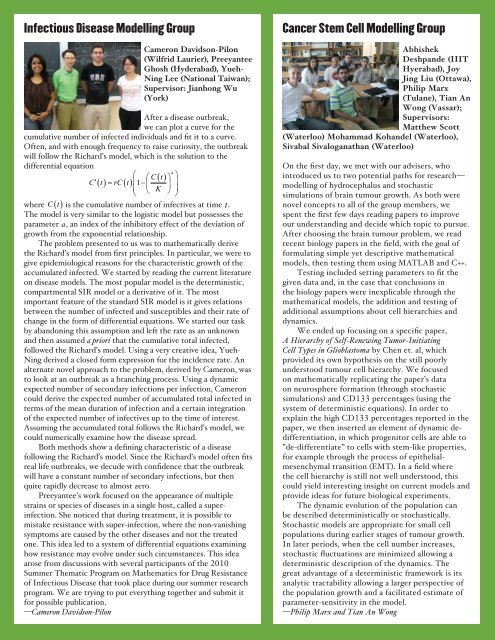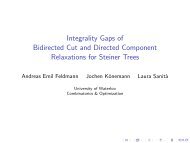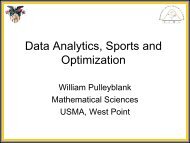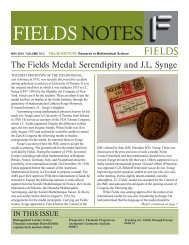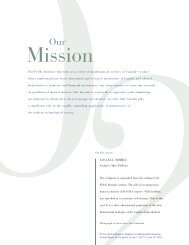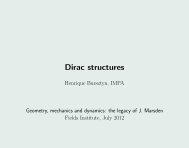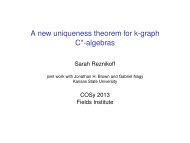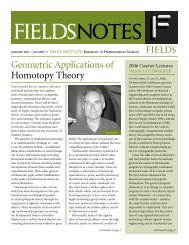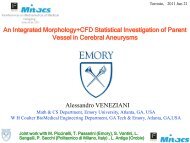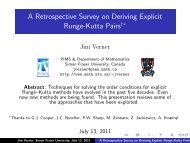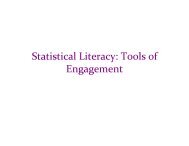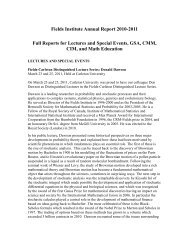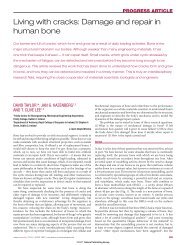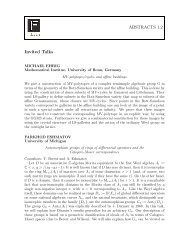SCIENTIFIC ACTIVITIES - Fields Institute - University of Toronto
SCIENTIFIC ACTIVITIES - Fields Institute - University of Toronto
SCIENTIFIC ACTIVITIES - Fields Institute - University of Toronto
Create successful ePaper yourself
Turn your PDF publications into a flip-book with our unique Google optimized e-Paper software.
Infectious Disease Modelling Group<br />
Cameron Davidson-Pilon<br />
(Wilfrid Laurier), Preeyantee<br />
Ghosh (Hyderabad), Yueh-<br />
Ning Lee (National Taiwan);<br />
Supervisor: Jianhong Wu<br />
(York)<br />
After a disease outbreak,<br />
we can plot a curve for the<br />
cumulative number <strong>of</strong> infected individuals and fit it to a curve.<br />
Often, and with enough frequency to raise curiosity, the outbreak<br />
will follow the Richard’s model, which is the solution to the<br />
differential equation<br />
a<br />
⎛ ⎛ C<br />
′(<br />
( t)<br />
⎞ ⎞<br />
C t) = rC ( t)<br />
⎜1−<br />
⎜ ⎟ ⎟<br />
⎜ ⎝ K ⎠ ⎟<br />
⎝ ⎠<br />
where C ( t)<br />
is the cumulative number <strong>of</strong> infectives at time t.<br />
The model is very similar to the logistic model but possesses the<br />
parameter a, an index <strong>of</strong> the inhibitory effect <strong>of</strong> the deviation <strong>of</strong><br />
growth from the exponential relationship.<br />
The problem presented to us was to mathematically derive<br />
the Richard’s model from first principles. In particular, we were to<br />
give epidemiological reasons for the characteristic growth <strong>of</strong> the<br />
accumulated infected. We started by reading the current literature<br />
on disease models. The most popular model is the deterministic,<br />
compartmental SIR model or a derivative <strong>of</strong> it. The most<br />
important feature <strong>of</strong> the standard SIR model is it gives relations<br />
between the number <strong>of</strong> infected and susceptibles and their rate <strong>of</strong><br />
change in the form <strong>of</strong> differential equations. We started our task<br />
by abandoning this assumption and left the rate as an unknown<br />
and then assumed a priori that the cumulative total infected,<br />
followed the Richard’s model. Using a very creative idea, Yueh-<br />
Ning derived a closed form expression for the incidence rate. An<br />
alternate novel approach to the problem, derived by Cameron, was<br />
to look at an outbreak as a branching process. Using a dynamic<br />
expected number <strong>of</strong> secondary infections per infection, Cameron<br />
could derive the expected number <strong>of</strong> accumulated total infected in<br />
terms <strong>of</strong> the mean duration <strong>of</strong> infection and a certain integration<br />
<strong>of</strong> the expected number <strong>of</strong> infectives up to the time <strong>of</strong> interest.<br />
Assuming the accumulated total follows the Richard’s model, we<br />
could numerically examine how the disease spread.<br />
Both methods show a defining characteristic <strong>of</strong> a disease<br />
following the Richard’s model. Since the Richard’s model <strong>of</strong>ten fits<br />
real life outbreaks, we decude with confidence that the outbreak<br />
will have a constant number <strong>of</strong> secondary infections, but then<br />
quite rapidly decrease to almost zero.<br />
Preeyantee’s work focused on the appearance <strong>of</strong> multiple<br />
strains or species <strong>of</strong> diseases in a single host, called a superinfection.<br />
She noticed that during treatment, it is possible to<br />
mistake resistance with super-infection, where the non-vanishing<br />
symptoms are caused by the other diseases and not the treated<br />
one. This idea led to a system <strong>of</strong> differential equations examining<br />
how resistance may evolve under such circumstances. This idea<br />
arose from discussions with several participants <strong>of</strong> the 2010<br />
Summer Thematic Program on Mathematics for Drug Resistance<br />
<strong>of</strong> Infectious Disease that took place during our summer research<br />
program. We are trying to put everything together and submit it<br />
for possible publication.<br />
—Cameron Davidson-Pilon<br />
6 FIELDSNOTES | FIELDS INSTITUTE Research in Mathematical Sciences<br />
Cancer Stem Cell Modelling Group<br />
Abhishek<br />
Deshpande (IIIT<br />
Hyerabad), Joy<br />
Jing Liu (Ottawa),<br />
Philip Marx<br />
(Tulane), Tian An<br />
Wong (Vassar);<br />
Supervisors:<br />
Matthew Scott<br />
(Waterloo) Mohammad Kohandel (Waterloo),<br />
Sivabal Sivaloganathan (Waterloo)<br />
On the first day, we met with our advisers, who<br />
introduced us to two potential paths for research—<br />
modelling <strong>of</strong> hydrocephalus and stochastic<br />
simulations <strong>of</strong> brain tumour growth. As both were<br />
novel concepts to all <strong>of</strong> the group members, we<br />
spent the first few days reading papers to improve<br />
our understanding and decide which topic to pursue.<br />
After choosing the brain tumour problem, we read<br />
recent biology papers in the field, with the goal <strong>of</strong><br />
formulating simple yet descriptive mathematical<br />
models, then testing them using MATLAB and C++.<br />
Testing included setting parameters to fit the<br />
given data and, in the case that conclusions in<br />
the biology papers were inexplicable through the<br />
mathematical models, the addition and testing <strong>of</strong><br />
additional assumptions about cell hierarchies and<br />
dynamics.<br />
We ended up focusing on a specific paper,<br />
A Hierarchy <strong>of</strong> Self-Renewing Tumor-Initiating<br />
Cell Types in Glioblastoma by Chen et. al, which<br />
provided its own hypothesis on the still poorly<br />
understood tumour cell hierarchy. We focused<br />
on mathematically replicating the paper’s data<br />
on neurosphere formation (through stochastic<br />
simulations) and CD133 percentages (using the<br />
system <strong>of</strong> deterministic equations). In order to<br />
explain the high CD133 percentages reported in the<br />
paper, we then inserted an element <strong>of</strong> dynamic dedifferentiation,<br />
in which progenitor cells are able to<br />
“de-differentiate” to cells with stem-like properties,<br />
for example through the process <strong>of</strong> epithelialmesenchymal<br />
transition (EMT). In a field where<br />
the cell hierarchy is still not well understood, this<br />
could yield interesting insight on current models and<br />
provide ideas for future biological experiments.<br />
The dynamic evolution <strong>of</strong> the population can<br />
be described deterministically or stochastically.<br />
Stochastic models are appropriate for small cell<br />
populations during earlier stages <strong>of</strong> tumour growth.<br />
In later periods, when the cell number increases,<br />
stochastic fluctuations are minimized allowing a<br />
deterministic description <strong>of</strong> the dynamics. The<br />
great advantage <strong>of</strong> a deterministic framework is its<br />
analytic tractability allowing a larger perspective <strong>of</strong><br />
the population growth and a facilitated estimate <strong>of</strong><br />
parameter-sensitivity in the model.<br />
—Philip Marx and Tian An Wong


